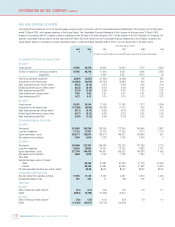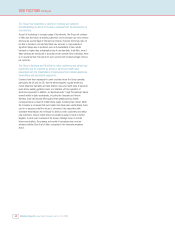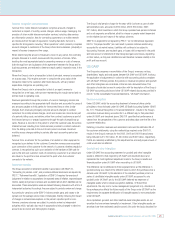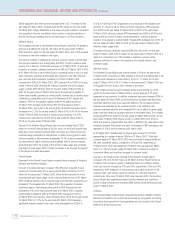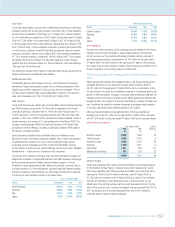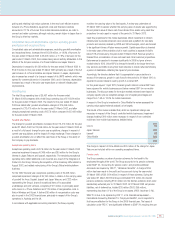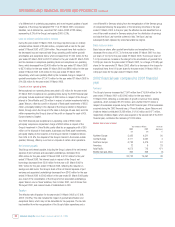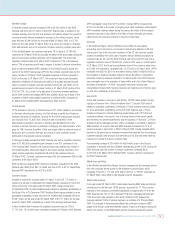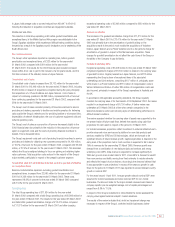Vodafone 2003 Annual Report Download - page 31
Download and view the complete annual report
Please find page 31 of the 2003 Vodafone annual report below. You can navigate through the pages in the report by either clicking on the pages listed below, or by using the keyword search tool below to find specific information within the annual report.
Vodafone Group Plc Annual Report & Accounts and Form 20-F 2003 29
Revenue recognition and presentation
Turnover from mobile telecommunications comprises amounts charged to
customers in respect of monthly access charges, airtime usage, messaging, the
provision of other mobile telecommunication services, including data services
and information provision, fees for connecting customers to a mobile network
and revenues from the sale of equipment, including handsets. Turnover is
reported for all segments, including “Other operations”which primarily comprises
amounts charged to customers of the Group’s fixed line businesses, principally in
respect of access charges and line usage.
When determining the amount of revenue to record in any period, the overriding
principle followed is to match revenues with the provision of service. When
deciding the most appropriate basis for presenting revenue or costs of revenue,
both the legal form and substance of the agreement between the Group and its
business partners are reviewed to determine each parties’ respective roles in the
transaction.
Where the Group’s role in a transaction is that of principal, revenue is recognised
on a gross basis. This requires turnover to comprise the gross value of the
transaction billed to the customer, after trade discounts, with any related
expenditure charged as an operating cost.
Where the Group’s role in a transaction is that of an agent, revenue is
recognised on a net basis, with turnover representing the margin earned and no
entries made to operating costs.
Revenues generated through the provision of voice or messaging services are
measured according to the appropriate tariff structure and accounted for gross of
any amounts payable to third parties for interconnect fees or other similar
charges. Such revenues principally comprise amounts charged to contract
customers for monthly access charges, which are invoiced and recorded as part
of a periodic billing cycle, and airtime, either from contract customers as part of
the invoiced amount, or prepaid customers through the sale of prepaid top up
cards. Revenue is recorded in the period in which the customer uses the service.
Unbilled turnover resulting from mobile services provided to contract customers
from the billing cycle date to the end of each period is accrued. Unearned
monthly access charges relating to periods after each accounting period are
deferred.
Turnover from a customer for the purchase of a handset or other equipment is
recognised upon delivery to the customer. Connection revenues are recognised
upon connection of the customer to the network. A customer, whether prepaid or
contract, is recognised as such upon activation of the handset or SIM card for
use by the end user customer. Costs of connecting a customer to a network are
also taken to the profit and loss account at the point when the customer
connects to the network.
Retirement benefits
The Group accounts for retirement benefits in accordance with SSAP 24,
“Accounting for pension costs”, and provides additional disclosures as required by
FRS 17, “Retirement benefits”. Application of SSAP 24 requires the exercise of
judgement in relation to assumptions for expected rates of inflation, expected asset
returns, salary and pension increases and a suitable rate at which liabilities can be
discounted. These assumptions used are derived following discussion with a firm of
independent actuaries. Accordingly, they are subject to periodic review and change.
Accounting for pensions under SSAP 24 allows certain gains and losses to be
spread over the average service lives of employees, thereby reducing the impact
of changes in actuarial assumptions on the period’s reported profit or loss.
However, pensions schemes are subject to periodic review by independent
actuaries which, typically, also result in assumptions being changed to take into
account any economic and demographic changes.
The Group’s total pension charge for the year, which is shown as part of other
administrative costs, amounted to £95 million (2002: £64 million, 2001:
£47 million). Most countries in which the Group operates have pension schemes
and so all segments are affected, albeit to a lesser or greater extent dependent
on the relative size and nature of the various schemes.
SSAP 24 is expected to be replaced by FRS 17 (or its international equivalent,
IAS 19, “Employee benefits”) and will result in pension scheme assets being
accounted for at market values. Liabilities will continue to be subject to
discounting. However, any resultant gains or losses will be reported in the profit
and loss account or statement of total recognised gains and losses, depending
on their nature, as they are identified and will therefore increase volatility in the
profit and loss account.
US GAAP
The Group also prepares a reconciliation of the Group’s revenues, net loss,
shareholders’ equity and total assets between UK GAAP and US GAAP, involving
the application of adjustments in conformity with accounting policies compliant
with US GAAP. Of these policies, the policies on revenue recognition and goodwill
and other intangibles are considered critical and are discussed below. This
discussion should also be read in conjunction with the description of the Group’s
US GAAP accounting policies and other US GAAP-related disclosures provided in
note 37 to the Consolidated Financial Statements, “US GAAP information”.
Revenue recognition
Under US GAAP, whilst the accounting treatment of revenue follows similar
principles to those followed under UK GAAP, US Staff Accounting Bulletin (“SAB”)
No. 101, “Revenue Recognition in Financial Statements”, results in the Group’s
connection revenues being accounted for in a different way to that prescribed
under UK GAAP and described above. SAB 101 specifies that performance is
viewed from the perspective of the customer and takes place over the life of the
customer relationship.
Deferring connection revenues and associated costs over the estimated life of
the customer relationship, using the methodology required under SAB 101,
results in the Group’s revenues for the 2003, 2002 and 2001 financial years
being reduced by £1,760 million, £1,044 million and £492 million, respectively.
Profits are materially unaffected by this adjustment as a broadly equal amount of
costs would also be deferred.
Goodwill and other intangibles
Under US GAAP, the accounting treatment for goodwill and other intangible
assets is different to that required by UK GAAP and described above and
represents the most significant adjustment made to the Group’s results and
financial position under UK GAAP when reconciling to US GAAP.
The difference can be attributed to three separate items: a) the difference in
goodwill arising as a result of the different basis by which the purchase price is
derived under US GAAP; b) the allocation of the resultant purchase price to a
series of identifiable intangible assets under US GAAP as opposed to only
goodwill under UK GAAP; and c) the US GAAP deferred tax treatment of
intangible assets which increases acquisition liabilities. Of these three
adjustments, the only one to involve management judgement is b). Allocation of
the purchase price affects the future results of the Group under US GAAP as the
requirements for separate identification of intangible assets is more prescriptive
under US GAAP.
Once capitalised, goodwill and other indefinite-lived intangible assets are not
amortised but are reviewed annually for impairment. Other intangible assets are
amortised over their estimated useful economic life under the basis described for





